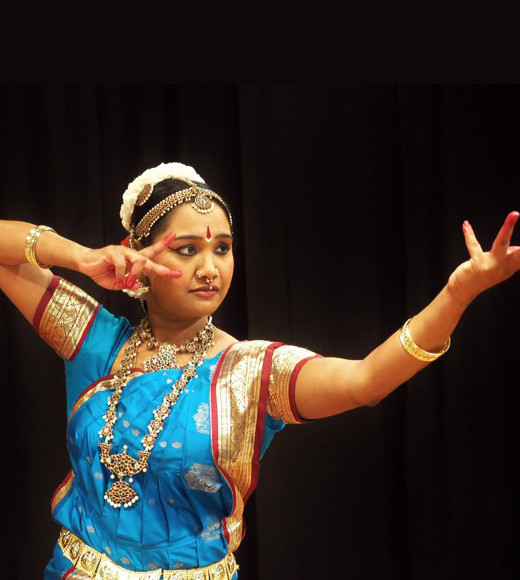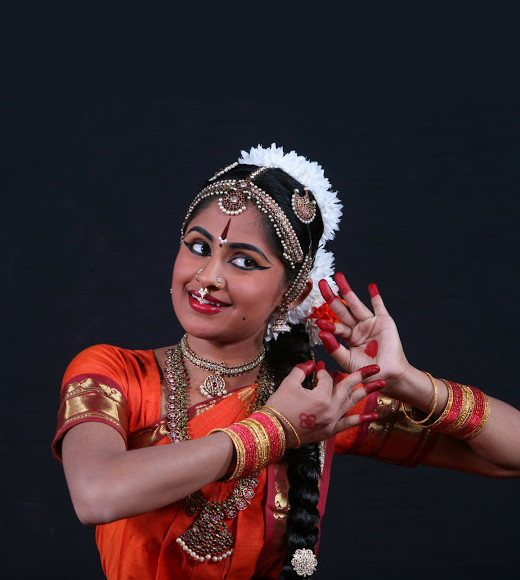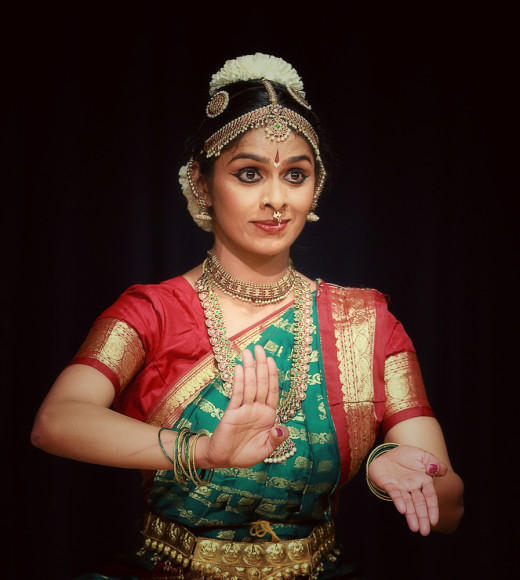At Vishwa Shanthi Dance Academy, we are committed to educating students in the sacred art form of Bharatanatyam, the classical dance style of South India. We believe that through self-discipline, dedication and the practice of this art form, the student will find inner joy and a higher expression of their true self, thus building a consummate individual. The student is therefore encouraged to enjoy and continue this journey of learning without getting caught up with the destination of an accomplishment.
Emphasis is given, not only, to the physical perfection of form and technique but also to the deeper understanding of the culture and mythology. Yoga and folk dance are taught as part of the curriculum to build flexibility, endurance and body movement. Annual performances give all students an opportunity to showcase their excellence.
Classes are held at several locations in Northern California. Along with the Artistic Director, Shreelata Suresh, VSDA is proud to have dedicated senior teachers who are excellent dancers in their own right and bring diversity to the school.

Shreelata Suresh is a dancer, teacher and choreographer of international acclaim. As the founder and director of the VSDA and VSPA, she has cultivated the love of Bharatanatyam amongst her students and audiences for over 15 years. Through VSDA, Shreelata plans to realize her vision of unification of the artist's skill and devotion to achieve an integrated development of the individual, the community and the world.
An accomplished exponent of Bharatanatyam and Kuchipudi, Shreelata Suresh, has carved a place for herself among the leading artistes in the United States today. “The clean geometry of her dance lines commands the attention of the most jaded of audiences,” writes a critic about Shreelata’s performance. As a cultural ambassador for India, Shreelata has shared the rich Indian heritage with audiences in over 25 countries through stage and TV performances. Her love of the art and her deep understanding of it are reflected in her presentations.
The Alliance for California Traditional Arts (ACTA) Apprenticeship Program has contracted Shreelata Suresh multiple times, as the master artist to offer intensive, one-on-one training to qualified apprentices. Vishwa Shanthi Dance Academy students have won acclaim for their solo and group performances. Many senior students are the lead choreographers of dance teams in their colleges today.
Her choreography is celebratory and contemplative at the same time. She combines the techniques of Bharatanatyam, yoga and meditation into a unified, powerful celebration of the human spirit. The group choreography, Poorthi, was nominated as a finalist at the Isadora Duncan Dance Awards.
Shreelata owes a lot to her illustrious Gurus, Vyjayanthimala Bali, Ramaswamy Bhagavathar, Dakshinamurthy Pillai and Delhi V Krishnamoorthy, whose teachings and blessings continue to encourage and guide her.
VSDA has a group of dedicated core teachers who manage the classes. They are always in touch with Shreelata and each other striving to make each class a better one for the students. All the branches are in sync with the overall school curriculum but at the same time, each teacher has the freedom of artistic expression to change the choreography depending on the class level and the student ability.
After the arangetram, the student, volunteers to teach children in the beginner classes as a way of giving back and sharing their experiences with the school.

Lavanya is a teacher at the Milpitas branch of VSDA which she started with Vijaya Saradhi. After her initial training in Andhra Natyam under the tutelage of Dr.Nataraja Ramakrishna (Perini SivaTandavam) and Acharya Kalakrishna, Lavanya has been continuing to learn Bharatanatyam under the tutelage of Guru Shreelata Suresh for more than 10 years. Lavanya is a member of Vishwa Shanthi Performing Arts and has participated in many of the productions.
Her many hobbies include reading and watching movies. She hates to cook but loves to eat!

Nisha is a teacher at the Peninsula and San Mateo branches of Vishwa Shanthi since 2013.
Nisha started learning Bharatanatyam under the tutelage of Smt. Shreelata Suresh from the conception of Vishwa Shanthi Dance Academy in 1999. She completed her Arangetram in April of 2009 and has performed in numerous Vishwa Shanthi productions and nationally at various venues, including the 2011 Nadaswaroopini Dance Competition in Pennsylvania, the Hare Krishna Temple in Utah, the San Francisco Ethnic Dance Festival, Yuva Bharati, and many others. She has also performed internationally at the 2008 Dance World Cup in Vancouver, BC and won first prize in the 2009 Prague Dance festival for the folklore/ethnic category.
Nisha has completed a certificate course in Bharatanatyam from Alagappa Performing Arts Academy of India under the guidance of Smt. Deepa Mahadevan and graduated from UCSD with a minor in Dance. She also completed her Yoga Teacher’s Training Certification at the Mount Madonna Institute.

Roopa started the San Jose branch of VSDA in 2011 and conducts classes for kids and adults. She also teaches classes at the Peninsula & San Mateo branches of the school.
Initiated at the age of 10, Roopa is an enthusiastic learner and practitioner of Bharatanatyam for many years now. She has been blessed with the opportunity to learn with many gurus in Chennai including the disciples of Guru Kittappa Pillai – a doyen of Bharatanatyam. This not only honed her skill in the art form but also helped her appreciate and imbibe the various nuances and subtleties. Roopa has been part of VSDA since 2008 and has participated in many of the major productions of the school including “Uthpala” and “Samudra Manthan”. She is one of the founders of Sanhiti (www.sanhiti.org) a popular South Indian dance troupe in the bay area that engages with the community through annual fundraisers for nonprofits. Besides being a busy mom to two active children, Roopa also devotes time working as a Publicist for Karadi Tales Company (www.karaditales.com).
Favorite Quote: “There are shortcuts to happiness and dancing is one of them”.
Once a dancer, always a dancer! The learning of this beautiful art form is an ongoing and continuous process. VSDA instills in the students the passion and enthusiasm for Bharatanatyam by making it structured and fun. The teachers actively demonstrate in class enabling the students to absorb the intricacies and subtleties of pure dance. Workshops and special classes teach the students expressions and the use of gestures to portray emotions. Yoga is a part of the curriculum and done every week.
All students take group lessons and the fees are paid at the beginning of the semester.
Semi-Private lessons are offered the year before the student is ready for her Arangetram for more individual attention.
Private classes with master teacher, Shreelata Suresh, are offered only to the student preparing for the Arangetram or a solo performance.
In the first three years of learning, the students learn the basic Adavus or the pure dance steps. A solid foundation is laid in these crucial years that will help the student achieve perfection in pure dance in the later years. These classes are held once a week for an hour each.
Students are introduced to simple combinations of the adavus in items and are set to music. Movement and control of the smaller muscle groups like shoulder, neck, and eyes are taught. Expressional items are introduced with the primary emotion being that of devotion to or praise of a deity. Different mythological stories are explored to learn about the various facets of the Asian deities. These classes are held once a week for an hour each.
The varnams and other complicated items are taught and practiced in the three to four years before the arangetram. Students perform in local community events to gain confidence and stamina. They are also encouraged to learn from visiting masters in special workshops and classes to hone their skills.
We welcome adults pursuing an interest that was either not available to them as a young child or given up during the school years. These classes are available only in select locations.
Though the development of each child is different, the ideal age is 6 years and above. Most children are ready physically and emotionally by this age.
Please find the contact information at the bottom of the site and contact us via phone or email to get in touch with member of the faculty to observe a class and recommend a class most suitable for him/her.
Depending on the stylistic differences and level of the student, they may have to relearn the basics to be consistent with our style.
Please refer to the CLASS tab to gain more information on our classes. As the student shows commitment and progresses at a steady pace, he/she will be invited to attend classes twice a week.
Yes. Students are dressed in Salwar Kameezes of particular colors to avoid unnecessary distractions. Please see below:
Class Attire – Wear salwar kurtas (short kurtas with slits on sides) with dupatta/sash tied tightly around waist. The colors for uniforms should be purple kurta with maroon salwar & dupatta OR maroon kurta with white salwar & dupatta (as pictured below).
NO dresses, skirts, jeans, shorts, or short tops. Older students (girls) should wear dance practice saris that can be bought in India or from the school.
Hair – Secure hair in a braid or ponytail. Use hair pins/hair bands to keep bangs and short hair off the face.
Jewelry – No dangling or large jewelry of any kind. Wear a bindi or pottu (the dot on the forehead).
Parents and families of students are welcome to watch the class, but while in class please refrain from talking loudly or doing anything that may be disruptive to the students’ learning. Do not video record any class without prior permission. The students will find their own methods of remembering what is taught to them. Feel free to audio-record the beats or the items or notate corrections.
Fees will be collected at the beginning the semester. A $15 charge will be applied for returned checks. We follow the school calendar and so each term will consist of 10 to 12 classes. For example: 1st term will be September – December. If a class is cancelled for any reason, then it will be rescheduled or the fees will be adjusted during the next term. Fees will not be adjusted for student absences.
It typically takes 7 – 9 years for the student to be ready for the Arangetram. The teacher has to see the necessary maturity and stamina in the student.
There will be two occasions for students to perform before others – on the occasion of Vijayadashami (Oct/Nov) and our annual day celebrations (March/April). All the students, irrespective of their level, will perform for their parents and friends. After reaching a certain level in dance, the students will be encouraged to perform in community programs and other group and solo dances, auditions and other opportunities.
The student is free to attend competitions after seeking the approval of their teacher. No special classes or attention will be given to prepare for the competition.
Make-up classes are the student’s responsibility. Classes can be made-up by contacting your classmates or attending a similar class at one of the 4 different locations of VSDA.
If a class is cancelled by the school for any reason, then it will be rescheduled or the fees will be adjusted during the next semester. Fees will not be adjusted for student absences.
In case of long absences (3 classes or more), students might be required to attend a private make-up class paying the private class fees – $50 an hour
It is important to practice because it reinforces skills learned in class and lays a strong foundation upon which the student can continue to build. If the student practices class lessons and appears in class well prepared, the teacher can continue the systematic process.
Students should practice at least 3 times a week and cover all the steps and items that the student knows over the course of the week’s practice.
Students should note details of practice sessions, including steps/items done, duration of practice and dates in a notebook that should be brought to class weekly and checked by the teacher. It is strongly recommended for a parent to monitor the student’s practice at least once during the week. Students may enjoy practicing with classmates periodically. It is understandable that students may not always be able to practice due to illnesses and vacations; but students and families must strive to make practice a priority and plan the week’s activities accordingly.
Evaluations, corrections and feedback are given to the student every class. If the parent has any special concern, please contact the teacher briefly after class or set up an appointment to speak or meet the teacher in person.
Please bring your own drink or water to class. A ruled notebook and pen/pencil to take down notes/a ring binder to file class handouts. Steps/items and practices must be noted down and kept up to date.
Uniform orders will be sent out 1-2 times a year, but please make every effort to procure it on your own during visits to/from India.
Learning materials will be provided through your student login upon enrollment. Theory and yoga will be taught in class.
The dance school will be closed for Summer and Winter vacations.